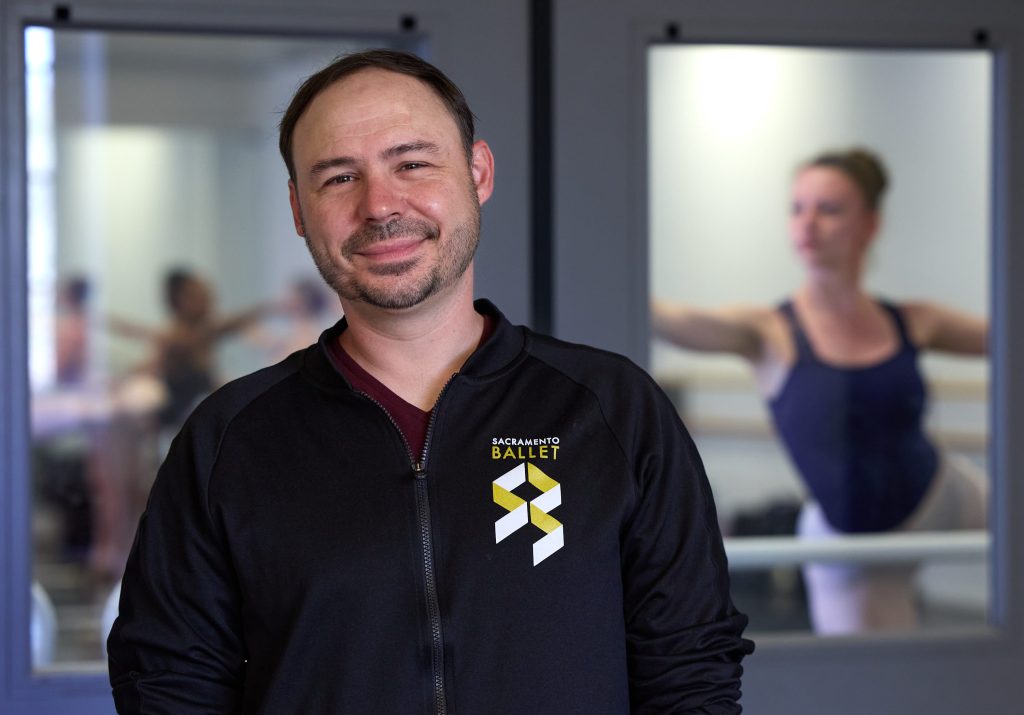By Jessica Laskey
Change is hard. For arts leaders engaged in the delicate act of passing the torch to the next generation, it can be particularly tricky to make sure the fire stays lit and that no one gets burned in the process.
Three Sacramento arts organizations — Sacramento Ballet, Celebration Arts and B Street Theatre — have experienced a changing of the guard in the last few years. For the latter two, that leadership transition marked the departure of a founder. At all three organizations, leadership was passed to someone significantly younger. The new artistic directors are all under 45.
Though each organization’s process was unique, they shared some common elements that may prove edifying for other arts groups, whenever they may find themselves at a similar inflection point.
Setting the stage
An arts group — or, perhaps more accurately, its board members — may decide to change leaders for any number of reasons. Sometimes the decision is made for them, as in the case of a retirement. Sometimes it’s an attempt to salvage a sinking ship by bringing in someone new who they hope will “save” the organization. In the best case, it’s simply part of the shifting sands of organizational management; people come and go, but the institution endures.
For Celebration Arts, the decision was made mostly out of necessity. In 2020, founder and longtime artistic director James Wheatley was 80 years old and still managing daily operations as well as directing many productions — as he had been for nearly four and a half decades, all the way back to the company’s origins in 1976. When lockdowns strangled the company’s lifeblood, ticket sales, the board spent reserves to stay afloat and cover their rent at 2727 B St., the former home of B Street Theatre, where they’d moved after losing their lease at a previous space.
But two years later, they were still financially strapped with new priorities coming to the fore.
“The conversation [about the change in leadership] seriously started during our annual meeting in the fall of 2022,” says Kelly McDole, Celebration Arts’ board treasurer. “At that time, we were in a unique and difficult position. We’re a 100% volunteer-based organization and have been for 37 years. We weren’t eligible for a lot of the COVID assistance because it was based on the number of employees — and we had no employees. Our volunteer base had dwindled to a core of 10 to 12 people, including nine board members.”
McDole said that board members knew going into that annual meeting that the organization needed to grow in order to cover higher rent and increase its budget to be able to hire for paid administrative positions. “That’s too much work for one person,” she says.
The board decided to take on some of the necessary roles itself. McDole became the de facto business manager, board member Nicole Manker took on executive director duties, and actor and board member James Ellison III, who’d worked with Celebration Arts for more than 20 years, volunteered to help Wheatley with artistic direction.

Ellison says he’d approached Wheatley about being mentored years before and that it had “always been in the air” that he would take over upon the founder’s retirement. When the board approved Ellison’s request to assume more of those duties, the wheels of transition started to turn.
Though Wheatley was not left out of the conversation, he says the transition still felt rather sudden. (The final board approval to install the volunteers in their designated roles occurred while Wheatley was unavailable.)
“He was in and I was out,” Wheatley recalls of receiving the news. But he recognized that the company’s survival trumped anything else. “My fear was that if I left [the company], it would die. I didn’t want that. If changes are made and it’s working, good. I don’t claim to have all the answers. I want to see the organization continue, in whatever direction.”
Ellison was officially named artistic director in 2023 and the first season he planned, 2024’s “Black Girl Magic,” features plays written and directed entirely by Black women. The theme is a testament to the women who helped build Celebration Arts, as well as those who are carrying it forward — including Imani Mitchell, a performer, director and playwright who’s been involved with the company since 2012.
“Sometimes you do need new folks in the door — new ideas, new ways of approaching things to lead the organization ahead,” Mitchell says. “Without James Wheatley, there is no Celebration Arts. But it’s good to bring in new folks with new energy to sustain but also elevate [the company] and figure out how else can it grow.”
‘Down to bare bones’
By contrast to the single leadership transition at Celebration Arts, Sacramento Ballet has actually had three over the last six years. First came the hiring of Anthony Krutzkamp as executive director in 2017.
Then, in 2018, the ballet’s board announced it would not be rehiring Ron Cunningham and Carinne Binda, the married couple who’d led the company as co-artistic directors for 30 years. Though there was a public outcry, the reason given by then-board president Nancy Garton was that the board was “doing a next chapter.” Amy Seiwert, a dancer who’d trained with Cunningham and Binda in the ’90s, was selected as the new head. She served only two years before she was laid off due to the pandemic and the cancellation of the company’s 2020-21 season.
Artistic-director duties then unofficially fell to Krutzkamp, a choreographer and former dancer himself. “Moving forward artistically was already on my plate without it even being said,” he says.
Krutzkamp spent nearly every waking hour at the ballet’s hub at the E. Claire Raley Studios for the Performing Arts poring over paperwork, getting the ballet school’s classes switched to Zoom, and figuring out a way forward. The board asked him to officially assume the dual roles of artistic and executive directors in 2021 and a new era at the ballet was born.
“It stripped away everything to just one base point: to look at our mission statement and what we were doing,” Krutzkamp says. “It was a completely clean slate. Now that it was stripped down to bare bones, we could build the way we wanted. I didn’t appreciate it then as much as I do now.”
The end of a reign
Early the following year, perhaps the most high-profile of the three transitions occurred at B Street Theatre. It was announced in January 2022 that Buck Busfield, co-founder of the professional theater company with his brother Timothy in 1986, would be stepping down.
B Street had recently moved into its new multimillion-dollar Midtown home, The Sofia, and weathered a particularly rocky first year after the pandemic knocked live arts for a loop. Busfield says the decision to step down came after realizing that he’d opened his dream venue, turned 70, and, “to be very candid, lost a bit of a bounce in my step — it was a long three decades.”
Though the board was initially intent on launching a national search for his replacement, Busfield says he insisted that internal candidates be considered due to their understanding of the uniqueness of the organization, which not only produces professional theater but also live concerts, children’s programming, classes, tours and more.
One internal candidate rose to the top of the list: Lyndsay Burch, who’d worked her way up from intern to associate artistic director over 10 years, and was only 30 when she was selected to assume the mantle from Busfield.
“In my opinion, it can be a mistake for a new leader to come in and immediately pivot a company in a way that is very visible to the staff, artists and community,” she says. “Change is difficult for everybody, so I had to be patient with myself and not come in and put a huge Lyndsay-sized stamp on things. It wasn’t flipping a switch the minute Buck left.”
What worked
Burch says the key reason the transition at B Street was so successful was because “Buck had empowered me a lot as the associate artistic director, which I’m very grateful for. As he started to step away, he removed himself from meetings and stopped offering his opinion. He gave me feedback, but he would always preface with ‘These were things that worked for me, but if it doesn’t work for you, it doesn’t. We’re different people and leaders.’”
Similarly, at Celebration Arts, Wheatley’s long-term mentorship of Ellison meant that the latter felt better prepared to take over thanks to the sharing of important insider information gleaned from Wheatley’s long tenure at the helm.
“We talked at least three times a week during the early transition times,” Ellison says. “He told me things the average person wouldn’t know unless they were in that role. He taught me that when you assume this position, it’s not just a title. Now you’re an actual community leader, especially when it comes to this particular theater. It’s a whole other world that he was trying to prepare me for.”
Though Krutzkamp didn’t have the luxury of long talks with his predecessor at Sacramento Ballet before assuming artistic duties, one thing he and Seiwert shared was a familiarity with the company and Sacramento itself, which went a long way toward helping them settle in, according to Julia Feldman, who’s danced with the company since 2011.
“Because Ron and Carinne were so established, it was a significant change for the dancers and the community,” Feldman says. “We’ve been lucky that in each transition, it’s always been to someone who is familiar with Sacramento and not a complete stranger, which made a really big difference. Amy had danced with Sac Ballet and came in already caring about this community. And by the time Anthony stepped in as artistic director, he’d already been working here as executive director and had really embraced the city.”
Feldman also notes that during the Cunningham/Binda transition, the board kept the dancers in the loop “as much as possible” and even invited a few of them, including Feldman herself, to be dancer representatives on the selection committee.
“That allowed transparency and access without us being too involved in the nitty gritty,” Feldman says. “We were able to provide some input and at the very least express what our priorities would be in passing on leadership.”

Board involvement may be key, but the way in which a board is involved can make a world of difference. Busfield says he is particularly grateful for the B Street board’s diligent and sensitive handling of the transition from beginning to end.
“The most important thing they did was take it off my shoulders — they drove the engine,” he says. “Under [then-board chair] Garry Maisel’s leadership, they were keen that we manage perceptions honestly and properly. The theater’s not mine or theirs, it’s the community’s. They wanted to make sure the process was honoring the investment of the community and the trust they bestowed on us. It was really important that the transition had the perception of stability, continuity and transparency.”
One stakeholder who agrees is Greg Alexander, B Street’s director of outreach and education and a longtime company member. “The transition from one artistic director to another can be really jarring, but it was really smooth here because of the commitment to maintaining the integrity of the company,” Alexander says. “The thing that makes us work is our incredible personal relationship with the community of Sacramento.”
What Didn’t
Information sharing at every step of the way is clearly crucial, but when the process gets truncated due to extenuating circumstances — few people plan for a global pandemic, for example — that can leave people feeling blindsided and scrambling for solid ground.
Since there was no real succession plan in place at Celebration Arts other than Ellison and Wheatley’s informal mentorship bond, Ellison says he still calls Wheatley multiple times a week to ask his advice about things that come up, even a year-and-a-half into his tenure. McDole says the board still seeks Wheatley’s counsel regularly. But the frequency of their calls might have been minimized had a more formal plan been in place before his replacement.
“A lot of times, the board doesn’t really know how much time it takes, what things need to be done,” Wheatley says. “They have ideas about what they want for the organization, but they don’t know the day-to-day operation because they’re not hands-on. It’s just one of those things.”
Krutzkamp was also effectively thrown into the deep end when Seiwert left, even despite his knowledge of the executive side. He says he wishes the board had made a more concerted effort to introduce him to key players in town, including philanthropists, city government officials and other arts leaders he might collaborate with, as well as ensuring he had all the basic information he needed to lead the company forward.
“My advice is, if you’re an artistic director right now and you’re leaving, leave all your info — where the contracts came from, who you spoke to. I didn’t have that; I had to hunt it down,” Krutzkamp says. “The board should ask the artistic director to furnish those things. If [the new person] has the information, then they can hit the ground running.”
Setting clear expectations among board and artistic leadership can also avoid unnecessary angst. As with most businesses, everything almost always comes down to money.
“If the artistic side does not reach a large audience, income falls short to support the company,” former Sacramento Ballet co-artistic director Cunningham explains. “The board then feels the shortage of funding is a result of inadequate artistic output and desire[s] to institute change in artistic leadership. So, whose fault is it, artistic or board? The management side usually falls on the board side of this equation because, after all, the board is the one who hires them. … The types of leadership in American ballet companies can often be at war with one another, and who creates its growth or downfall is interconnected in the equation.”
Lessons learned
Planning ahead for the eventuality of leadership change seems to be the most-cited wish among the people who’ve recently been through the process. Having a succession plan in place and a roadmap of what information needs to be shared can make a potentially stressful process much less fraught.
B Street’s Busfield gave the board plenty of warning when he decided to step down, which allowed them the time to plan a smooth transition, from finding his replacement to training and installing the new artistic director. Once Burch was hired, she was brought in on every important meeting, given every budgeting and management detail to, as she says, “make sure I knew what I was inheriting,” and she was introduced at every function for the six months leading up to the official start of her tenure as “the incoming artistic director.”
And while transitions bring new faces and visions to evolving organizations, passing the torch doesn’t mean erasing legacy, but rather, adding to it.
“I’m not trying to replace James Wheatley because you cannot,” Ellison says. “What he did and what he’s doing, you can’t replace that or duplicate it. It can never be done again. I just want to put my little spin on it, my paprika on it. I’m not reinventing the wheel or trying to fill his shoes, I just want to keep the company going.”
This story is part of the Solving Sacramento journalism collaborative. Solving Sacramento is supported by funding from the James Irvine Foundation and the James B. McClatchy Foundation. Our partners include California Groundbreakers, Capital Public Radio, Outword, Russian America Media, Sacramento Business Journal, Sacramento News & Review, Sacramento Observer and Univision 19.






Be the first to comment on "Passing the torch: Three Sacramento arts organizations navigate leadership transitions"